
Point Pelee Part 5: Blackpoll Warbler - House Wren
May 22nd, 2010
Blackpoll Warbler: Sort of a chickadee lookalike, the Blackpoll is among the most northern of the warblers, favoring, for its nest sites, stunted spruces and firs at the far edge of the boreal forest. It undergoes an impressive long-distance migration: all the way from South America to northern Canada (and Alaska), and back again in fall. Its song is so high-pitched that some people can't hear it.
This is me taking another liberty. I couldn't photograph the one that showed up at Point Pelee, but got an excellent shot at Mud Lake on Wednesday.
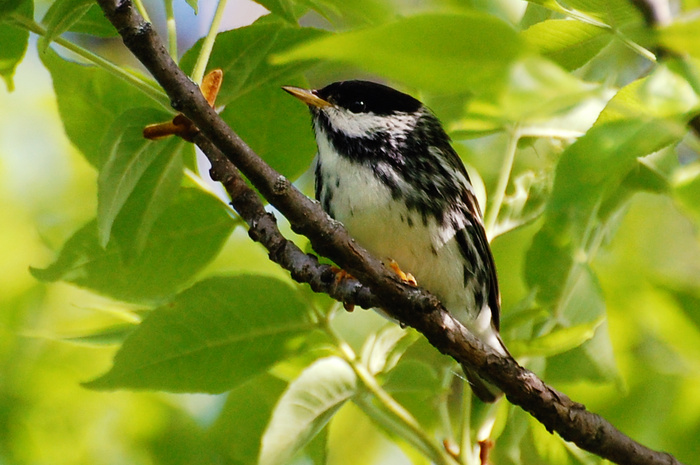
Blue-Gray Gnatcatcher: a tiny, sprightly insectivore. This is a southern bird, rare in Ottawa, but much more common just a few hours south of us. (Also common in Virginia: I've seen bands of them in my parents' back yard.) We saw the species most abundantly (or at least most visibly) in the woods of Oshawa Second Marsh. We also found active nests in a few places. Gnatcatcher nests are really well camouflaged--they just look like tree burls.
Blue Jay: Flocks of these hovered in the air right over the tip of the point. Just hovered, not seeming to go anywhere (maybe because of the strong wind). It was weird--pleasantly surreal. Not sure what they were doing up there since Blue Jays aren't migratory, maybe flycatching? Maybe having fun?
Cape May Warbler: Found a beautiful male, close up and in plain view at Point Pelee--lifer! This warbler, a boreal species that nests in spruce, is seldom seen even in migration--there just aren't that many of them. I managed to get a picture of one at Thickson Woods, although it was kind of far away for my lens.
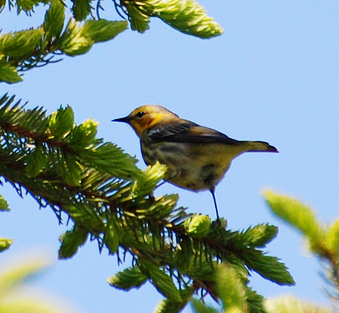
Chestnut-Sided Warbler: A common but pretty breeding bird in scrubby habitats.
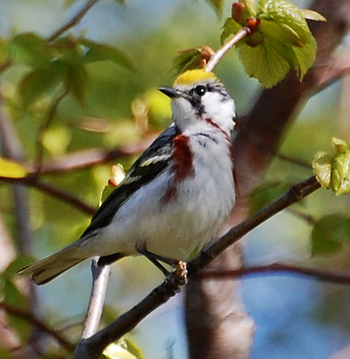
Common Nighthawk: We noticed a large group of people with scopes at a particular point along the trail at Rondeau Park, joined them, and found they were enjoying the sight of a Common Nighthawk resting high up in a tree. Not a lifer, but a bird I seldom see, and the first time I've seen one perched. Nighthawks are semi-nocturnal birds who come out at dusk and dawn (seldom when the sun's up) to hunt insects on the wing. They're identifiable in flight even at a great distance thanks to the white bars across their wing tips (picture).
Despite the name, nighthawks aren't raptors. They're in the same family as Whippoorwills.
Eastern Towhee: One of the handsomest of sparrows, with rufous flanks and deep reddish-brown eyes (see Part 3 for a photo.) Rare in Ottawa, common further south. We only saw one, though.
House Wren: A common species in woodlands everywhere. Lifer! (One of them even fooled me into thinking it was a Brown Creeper, at first. Around these parts, when you see a little brown bird scaling a trunk it's a pretty safe assumption that it's a Brown Creeper. In far-southern Ontario, not so.) I believe I found House Wrens in every location we visited, and I quickly ramped up from knowing very little about them, to recognizing them instantly by sight and sound.
According to the Ottawa checklist they're not rare here, but I'm beginning to wonder if the checklist needs updating, because not only had I never seen one, I don't think I'd ever heard that song either.
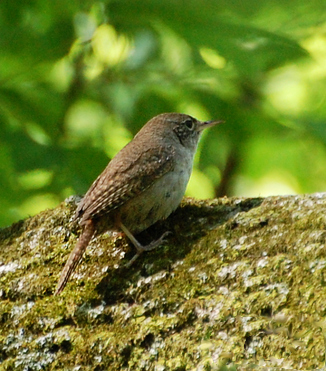
To be continued...
Point Pelee Part 4: Baltimore Oriole - Blackburnian Warbler
May 21st, 2010
I'm leaving out a lot here, obviously. I'll list any birds of particular interest, and any that I have photos of.
Baltimore Oriole: Ubiquitous--more so than in Ottawa, where they're already a pretty common sight. People put up orange nectar feeders to attract them, and halves of oranges stuck on posts. (Apparently Baltimore Orioles are attracted to the color orange when feeding. Perhaps it helps them attain the pigments they need for their brilliant plumage.)
At Point Pelee itself, Baltimore Orioles are (or were, at least, on Friday) unbelievably common, the trees teemed with them, their songs filled the air. Between them and the Orchard Orioles, it was oriole central, and finally on Friday afternoon Ken snapped and reacted to a sighting with "another wretched oriole." ("Aren't we becoming jaded!" one man laughed.)
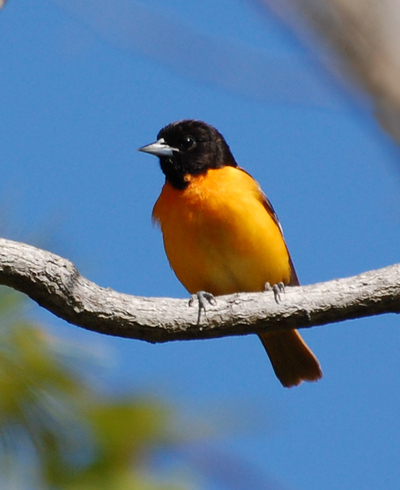
Barn Swallow: A very abundant species anywhere that was close to Lake Erie. At Point Pelee, they nested right under the roof of an open-sided building by the park entrance. The building was small and had people constantly streaming in and out of it, but the swallows didn't seem to mind in the slightest. I guess they're used to it.
At Rondeau, I found a group of them at a mud puddle. Barn Swallows frequent mud puddles in spring to gather material for their mud nests, which they build, usually, on ledges and ceilings in man-made structures.
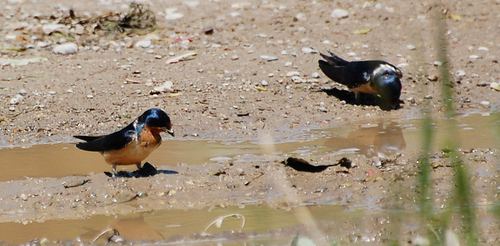
Black-And-White Warbler: An atypical warbler who creeps along trunks and branches like a nuthatch. I photographed this one at Rondeau.
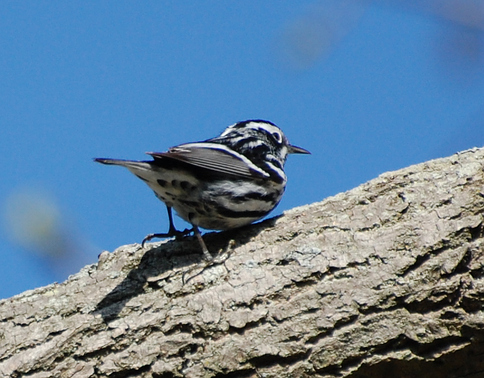
Black-Throated Blue Warbler: A striking deep-woods warbler. Depending on lighting, the male's back can look anywhere from grey to a fairly vivid blue. I've seen them on breeding grounds on the forested mountains of Gaspé, only infrequently in migration, but enjoyed several sightings at Point Pelee. I'm cheating with the photo, though--I actually took it at Mud Lake on Wednesday :-)

Blackburnian Warbler: The "flamethroat." IMHO, the most beautiful songbird in North America (click the link to see why.) A male graced us with his presence at Point Pelee.
To be continued...
Point Pelee Part 3: The Places
May 20th, 2010
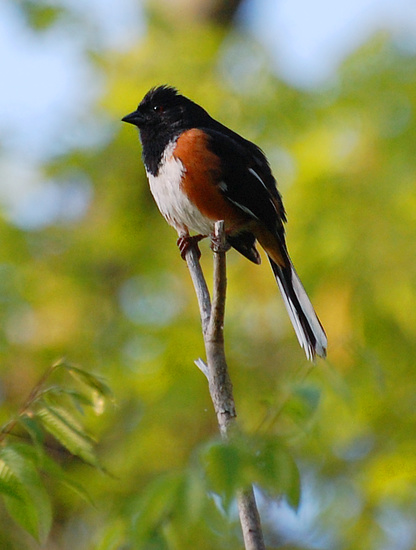
Eastern Towhee at Rondeau Provincial Park
Day one: Oshawa Second Marsh (was supposed to be Hillman Marsh)
Day two: Point Pelee (the point itself in the morning, Tilden Woods in the afternoon)
Day two, early evening: Hillman Marsh
Day three: Rondeau Provincial Park, morning and afternoon
Day four: Thickson Woods (near Toronto), briefly, en route to home
The decision of whether to take camera or binos, on any given birding outing, is often a difficult one. The binos are far better for in-the-moment enjoyment and for spotting, while the camera gives me more tangible memories to enjoy afterwards, and more to share with friends. This time the decision was agonizing. I can't do both and do justice to both: one must take priority, with the other stowed at my side or, ideally, left back at the hotel room. (They are just too unwieldy to carry them both around my neck.)
I ended up deciding to use binos for the first two days, and camera for the last two. On the binos days, the camera stayed on the bus or in the hotel room. What I didn't realize is that none of the other locations we birded could even hold a candle to Point Pelee. There was no comparison. Not just because there were far fewer birds and less variety of birds, but because, especially at Rondeau, most of the birds were breeders, not migrants. Breeders go about their business, often in the very tops of trees, and aren't necessarily that conspicuous unless you catch them singing--and again, they often sing at the tops of trees. Migrants flit around visibly, forage actively, as they fuel up for the next migration step, sometimes coming down much lower than they would during breeding time. They aren't "settled in", as it were. So, in sum: got a few good pictures, but not as many as I was hoping for.
If I had realized all that, would I have done things differently? Well...probably not. Point Pelee was a visceral thrill, and if I'd been in photographer mode, that thrill would have been seriously dampened. I would have missed a lot of birds, the ones I didn't miss, I probably wouldn't have seen as well, and I would have been too busy focusing on the work of photography to have all the "oh my god, that's my very first [x], it's beautiful!" moments.
All this means, of course, that I must go back. I must go back so I can take pictures, and I must go back just because. Because Point Pelee was breathtaking. I've never heard so much birdsong at once, as soon as I got off the bus. I've never seen anywhere near so many different species in one day. And all that said, one of the most thrilling moments was not about birds or not just about birds: it was when I came out onto the very tip tip of southern Ontario. Vast expanses of open water all around me, and a thick morning mist hanging over it. No far shore visible anywhere, not even after the sunrise burned the mist off. Everywhere I looked the world dropped off. Just off the point, huge swirling flocks of gulls and terns and cormorants dove for fish. It was magical. It felt like being at the ocean. The Great Lakes should be called freshwater seas.
Let me just cut to the chase and give you the full species list. Here are the birds I personally found during the four-day trip--including en route. Lifers are starred; birds that were only heard, not seen, are marked with carets.
( Cut as a courtesy to non-geeks )
That's 96 species seen, 10 heard, and 10 lifers. Of those, 70 were seen/heard at Point Pelee in one day, including all 21 of the warblers.
Point Pelee is a place where migrant birds have just finished their trip across lake Erie. Assuming they're songbirds, that means not stopping once across the whole stretch, because songbirds can't swim (except for the rare oddity like the American Dipper). So when they arrive on the far shore, they crash--the way we all did at the hotel at 10:45pm--and they stay put for awhile. That's why Point Pelee rocks.
There is another reason why this whole region is famous with Canadian birders and Canadian naturalists: it comprises the far-northern tip of the Carolinian forest region. That means a very different assortment of trees, wildflowers, insects, reptiles, and last but not least breeding birds than we see up in places like Ottawa. Having grown up in Virginia, I was particularly amused by the big to-do about ticks. Far-southern Ontario has ticks. There was a lecture about it on the bus--what they look like, how to get them off once they've dug in, how to do tick checks--and the awed reverence with which people treated the subject made me smile. Just wait'll you meet chiggers, folks. You ain't seen nothing yet.
There are a number of interesting birds whose breeding range extends into Point Pelee but not much further north. Birds who are basically linked to the Carolinian forest. So while we come to Pelee for the migrants, we also come for those southern breeders that we can't find (or can only find with great difficulty) back home. Rondeau Provincial Park is one of the top places to see them. The one disappointment of the trip was how few of them I saw--in particular, I saw not a single one of the many southern warblers (to wit, Golden-Winged, Blue-Winged, Brewster's, Prothonotary, Hooded, Worm-Eating, Prairie, Kentucky, Yellow-Breasted Chat, Louisiana Waterthrush) that I had been hoping and rather expecting to see, all of whom would have been lifers. Many of them were around; I was just unlucky. Some in my group had better luck--some even saw the ultra-rare, endangered Kirtland's Warbler that showed up at Point Pelee on Friday--but I never happened to be in the right sub-group at the right time.
I choose to look on the bright side. If I tick off every possible lifer at high speed, I will soon get to the point where I have to go on long trips to the western provinces, or even other countries, to see something new. I have my whole life to enjoy this hobby. There's no rush.
And there will--I repeat, THERE WILL--be future trips to Point Pelee in May! And I will be awake and ready at oh five four five in the morning to go see the birds at Point Pelee in May!
In the remaining parts, I'll talk about some of the interesting species I saw, and share the rest of my photos.
My cup runneth over...
May 19th, 2010
...with CUTE BABY GOSLINGS!
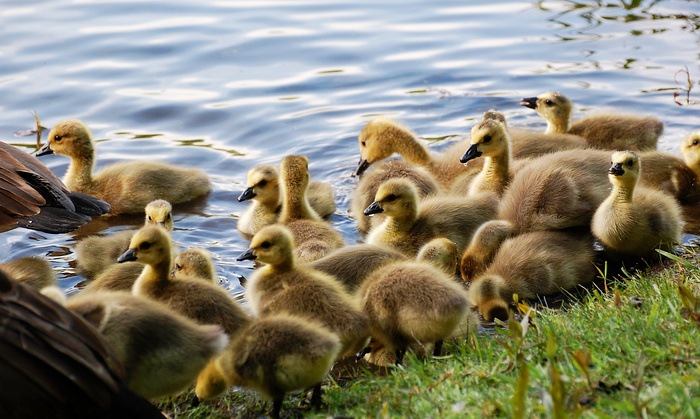
1680x1050 wallpaper
All the Canada Geese parents at Mud Lake have hatched their young and formed a creche in the usual place, along the north shore.
Point Pelee Part 2: The People
May 18th, 2010
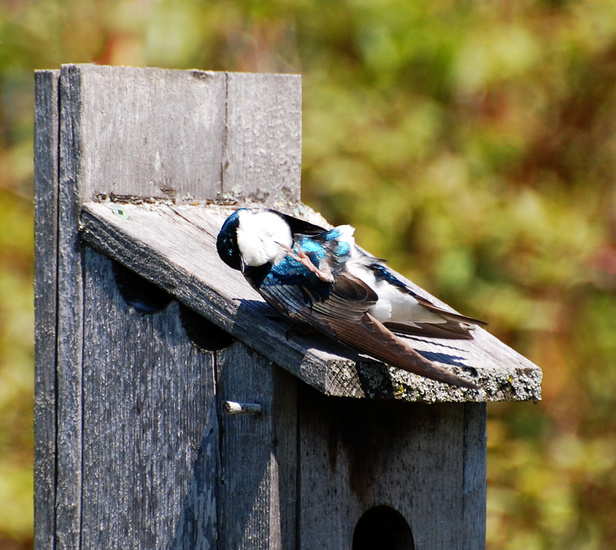
Tree Swallow on a nest box at Thickson Woods. Itchy scratchy!
First, all about our two leaders: Roy and Ken.
Roy was sort of a drill sergeant for a good cause. He's the fellow who said, "the bus will leave at oh five four five point zero zero zero" and "rule number one: do not stand in the door of the bus. There are almost forty people on the bus and none of them can get off if you stand in the door. Rule number two: do not stand in the door of the bus. Rule number three: if you stand in the door of the bus, I will push you out."
Helpful, knowledgeable, and dedicated. An absolute ace at bird ID, even when all he got was a glimpse. As for his stickler rules, they were all for our sake--to insure that everyone had a great time, that no one person's carelessness sabotaged other people's enjoyment.
Ken was the type B to Roy's type A. The good cop to Roy's bad cop. The guy who exuded good humor and patience and generally had fun with it. The guy who said, after I and another woman arrived on the swamp boardwalk about fifteen minutes later than the rest of the group, all of us searching for the beautiful nesting Prothonotary Warbler, "you missed it." And then waited just a few moments for that to sink in before breaking into a grin and adding, "so did we."
Equally helpful, knowledgeable, and dedicated. Obviously an experienced naturalist, maybe a career naturalist. Always trying hard to maximize everyone's experience. After a bunch of us had been watching some interesting bird for a period of time, and we were about to move on, he'd ask a question like, "has anyone still not seen the [species name] who wants to?" And if someone said yes, he'd maneuver them into position, point, and give treasure-map-esque directions ("okay, see that fork in the big pine tree?") to the bird.
In case you can't tell, I really liked both of the leaders: they were an excellent team and the way their personalities played off each other was a source of amusement, at least to me.
I also overwhelmingly liked the group as a whole, and made all sorts of connections with all sorts of people. I constantly seemed to be ending up in mingle circles, chatting freely about various birdy things. Yes, really. Me, in mingle circles! The strong common interest, I guess, is what made it happen. It just came naturally.
There was a rather thrilling moment, socially, on the bus going home, when Ken stood up at the front and we all helped put together the communal trip list. He listed off all the species of birds in all the various categories (herons, warblers, sparrows, etc.) that he knew of that we had seen, and for each category, if someone had seen a bird in that category that wasn't listed, they spoke up. He sometimes mentioned likely omissions, e.g. "has anyone actually seen a Wood Thrush?" (Answer: no. We heard plenty, spotted none. Typical!)
It was thrilling because all that systematic, geeky, science-y stuff that I've always done privately--making trip lists, marking which birds I actually spotted and which I only heard, etc.--was now being done as a group. (Although, of course, I also maintained my private list which I will share with you in due time.) And they were as keen to get it down and get it right as I was. It was a thrilling sense of belonging, of having found a community.
I've been to a few other OFNC events, but none that worked nearly as well, socially, as this one. Now I want more. Now I want to spend more time with these people. Go on more events. Maybe even go to the monthly meetings.
Point Pelee Part 1: The Bus Trip From Hell
May 17th, 2010

Male Red-Winged Blackbird photographed at the Thickson Woods marsh. Also, what my mood looked like around midday Thursday.
I'd call the trip to Leamington a "comedy of errors" except that there was nothing funny about it. It started in the parking lot of Lincoln Fields. Our driver discovered a problem with the brakes on the bus. It was a dangerous enough problem that we couldn't leave without getting it fixed. We ended up waiting over an hour before the replacement bus got there.
Then, some hours out of Ottawa, the air conditioning broke down. And the driver refused to go on without it. I didn't think the temperature was that bad--it was mid-May, after all, not mid-July--but apparently at least a few people did and the matter was not put to a vote. The replacement bus had to come all the way down from Gatineau; as you can imagine, that took awhile. In fact if I remember correctly it was something like five more hours before we finally boarded bus number three.
The good news is, our excellent leaders came up with an excellent "plan B": while we were waiting for the second replacement bus, instead of standing around in a parking lot, we would go to nearby Oshawa Marsh and bird it. We had a fine time there and some good birding, including my first two lifers of the trip: House Wren and Trumpeter Swan. Then, when the replacement bus still hadn't arrived, we stopped next to several fast food restaurants and had dinner.
We finally made it to the hotel, tired and bedraggled, around 10:45 pm. And I promptly turned in for a 4:15am wake up the next morning. As is my wont anytime I'm spending the night in a new location, I got not a single wink of sleep. (Didn't help that something in the sheets gave me an allergic reaction.) Add to this the fact that the night before, at home, was also virtually sleepless, and that was some pretty impressive sleep dep I racked up. I had serious doubts as to how well I would be functioning on this trip and particularly on the next day.
As it turns out I did just fine, more than fine, I did great. Throughout Friday, on zero sleep, I burned my candle at both ends--not merely a solid morning of birding, not merely a solid morning and solid afternoon of birding, but a morning, afternoon, AND early evening of birding! About twelve hours all in all, twelve hours with breaks but still twelve hours. By the end of it, a double whopper and onion rings were only just enough to fill the hole in my stomach. I think I got to the point where I was substituting food for sleep.
The following two nights I slept well. I never even began to make up for the sleep dep, yet I thrived in spite of it (except for a lingering bronchitis, which came back on me with a vengeance during this trip.) And there were no more snafus, for the rest of the trip.
A quick shout out from a public terminal
May 15th, 2010
Day 1 of the Point Pelee trip: "Comedy of errors" does not even begin to cover it. The bus was schedule to leave at 6:00am. The trip was to be about 8 hours, plus about 2 additional hours of birding en route at Hillman Marsh. We checked into the hotel at 10:45pm. You do the math.
Seriously, we're famous here now. We run into random people on the trails and they're all "oh, you're the Ottawa group. We heard about that."
Day 2: Point Pelee is unbelievable. Incredible. Astounding. Awe-inspiring. And many other adjectives. In one morning + afternoon, I racked up five lifers and a downright dizzying full species list that included something on the order of twenty different warblers. (It was an incredible place for other reasons too, which I'll describe in a later, much more detailed post.) I will go back someday. Oh god, so help me, I WILL go back someday.
Day 3 (today): Rondeau Provincial Park was nice, but does not deserve to be mentioned in the same sentence or even the same paragraph as Point Pelee. Unfortunately, not knowing that, I took the camera out today instead of yesterday. Still got a few good pictures though.
Day 4: The trip home with a birding stop at Thickson Woods. I plan to be camera-enabled, if weather permits. Wish me (and all of us) luck that the trip home will not be as much of an "adventure" as the trip here.
Mud Lake, May 10th
May 12th, 2010
As the early nesters bear, raise, and even fledge their young, other species are only just beginning. The next big wave of spring migration has hit.
Baltimore Orioles are back--three flame orange males at various locations around Mud Lake, all of them camera shy. American Redstarts are back and singing. Cedar Waxwings have returned from wherever they wandered to last winter (it's variable), and are now present in flocks throughout the BCA. Catbird songs emanate from every other bushy thicket. And Warbling Vireos and Yellow Warblers are singing their little hearts out.
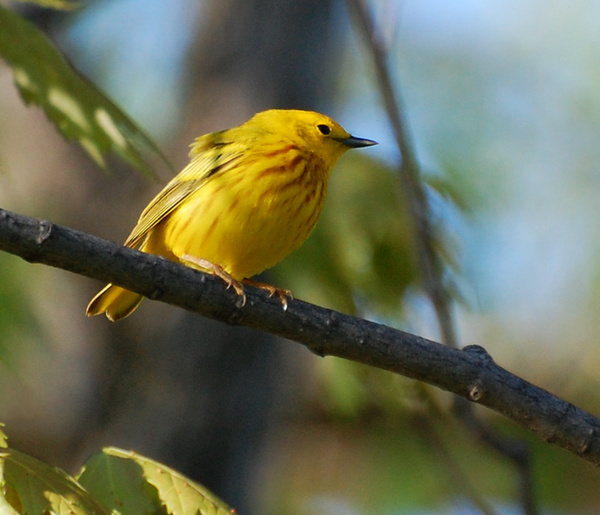
1680x1050 wallpaper
On Tuesday afternoon, insect swarms by the Ottawa River attracted an impressive mixed flock of literally hundreds of swallows and swifts, whizzing through the air at high speed as they snapped up whatever they could. I love swallow-watching, though I don't usually attempt it with a camera--they just move too fast. I guess I was a glutton for punishment that day, because I tried it anyhow. I was rewarded with a surprisingly well-focused shot of a Chimney Swift.
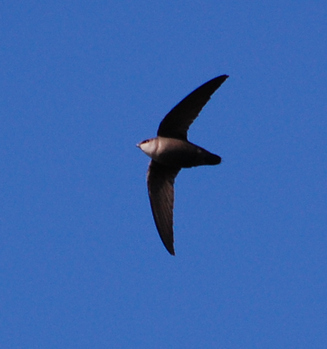
Swifts are the most aerial class of birds in the world--and Chimney Swifts are no exception. Unless they have young to tend, they spend literally the entire day in the air. They are incapable of perching. They're common birds, but unless you find a nest/roost site inside a chimney or hollow tree (where they cling to vertical surfaces), the only way you'll ever see them is in flight. Swifts remind me of bats--their strange nesting habits, their irregular, fluttery flight--but they're birds, most closely related to the hummingbird family.
Trivia point: authentic Bird's Nest Soup is made from the saliva of Cave Swiftlets. As if they weren't batlike enough, some cave swifts use echolocation to find their nests in the dark.
All three of Mud Lake's breeding herons (Great Blue, Green, Black-Crowned Night) are back on territory. Great Blues have been back for awhile, but this one on Tuesday was my first of the year.
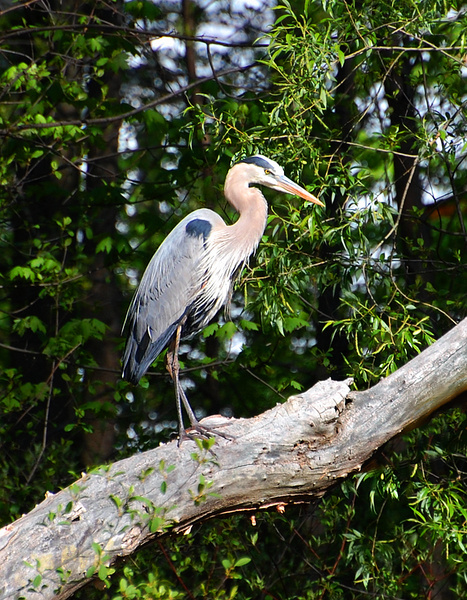
I've seen little variety of migrant warblers so far this year--haven't been out at the right times and places, I guess. That's fine, since tomorrow I'm off to Point Pelee, migrant warbler capital of the world!
A Time For New Life
May 11th, 2010
Yesterday at Mud Lake, something I'd never witnessed before: Red-Winged Blackbirds mating! In my years as a birder it's one of the most charming things I've ever seen.
( Cut for the bashful )
For others, there's already new life.

Specifically, two very yellow, very fluffy, and very newborn Canada Goose goslings. I don't know if they've even been in the water yet--that bit of wetness on his down may be from hatching. The parents are still very protective, hissing if I get too close. (Later on, they'll warm to humans again and even teach their young how to solicit handouts.)
Elsewhere around Mud Lake, patient mothers continue to brood. Once all the goslings are hatched, the parents will gather them together into a creche for communal protection.
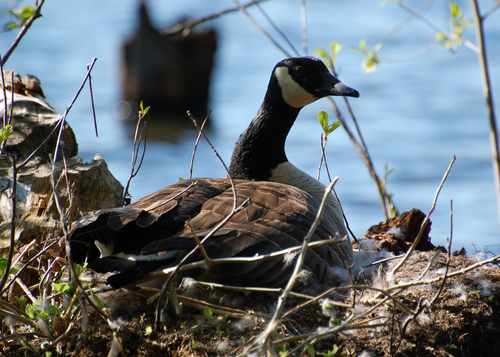
A very few are further along still. Ravens lay their eggs as early as February. The raven's nest at Mud Lake already has fledged young. The teenage ravens are flying around in the canopy near the nest, calling back and forth to each other and generally making an ungodly racket any time of day.


South-of-the-airport birds
May 5th, 2010
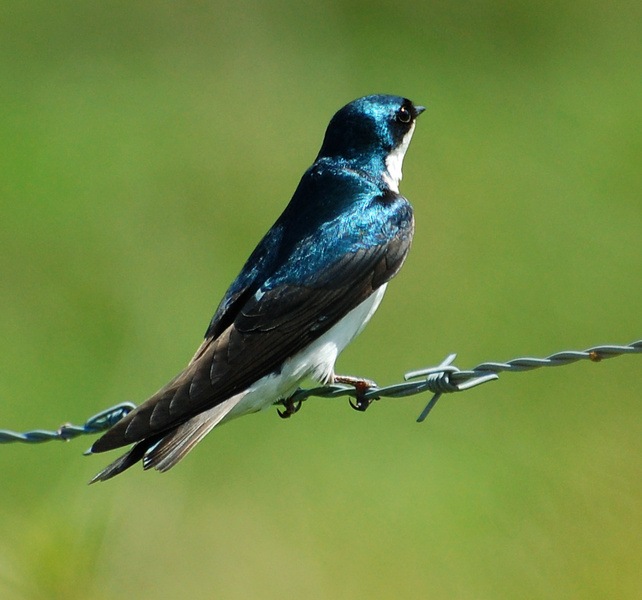
Tree Swallow, wallpaper available
I heard far more than I saw, south of the airport today--and saw far more than I photographed. The birds were active but elusive.
As were the butterflies. They're out in good numbers now--Spring Azures, migrant Red Admirals, plus, a new one for my unofficial "butterfly lifelist": a Black Swallowtail. None of them would stay still for a picture.
Though it was afternoon, not morning, there was lots of birdsong. Field, Vesper, Savannah, Song, Chipping and White-Throated Sparrows all going at it, plus a Warbling Vireo or two--a recent arrival in Ottawa as of the past week. A Brown Thrasher joined the chorus as evening moved in.
Emanating from a fenced-off field, I could hear the sweet, plaintive song of an Eastern Meadowlark. It was almost enough to tempt me past the fence--meadowlarks are as beautiful as their voices are sweet--but there are signs posted, and I don't know if they're "no trespassing unless you mean well" signs or "NO TRESPASSING" signs, so I didn't. I also saw and heard a Bobolink in his ecstatic flight display, which marks my first Ottawa sighting of that species, and glimpsed a Northern Harrier, both in the same fenced-off field.
The one species that was available for as many photographs as I cared to take was Tree Swallows. Oh my goodness, the Tree Swallows. Tree Swallows left, right and center. Tree Swallows in the air, in the fields, on the lines, and on the nest boxes. And they look like they have every intention of taking over as many of those boxes as they can.
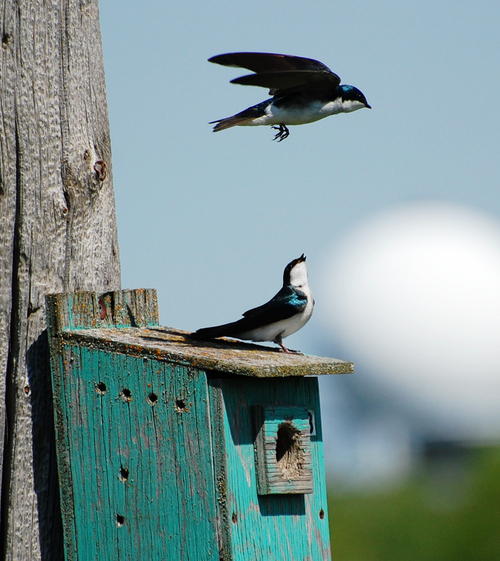
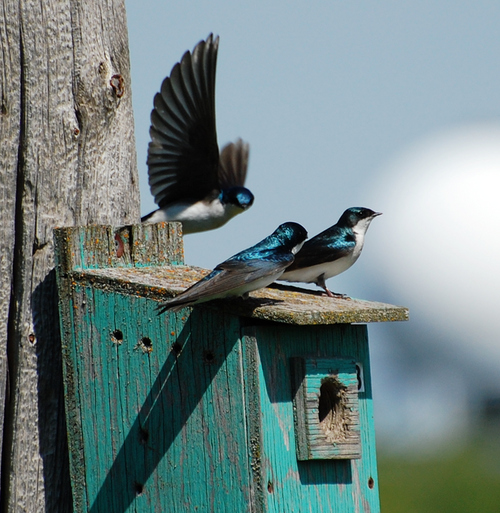
There was much squabbling. "My nest!" "No, my nest!" "Oh yeah?!" Um, guys? These boxes were intended for bluebirds. And while you are, technically, blue birds, I'm pretty sure that's not what was meant.
As for the actual bluebirds, they were around, although not nearly as numerous nor as noisy as the swallows, nor were they showing any interest in the nest boxes. Perhaps there are boxes elsewhere that they favor. Must do more exploring.
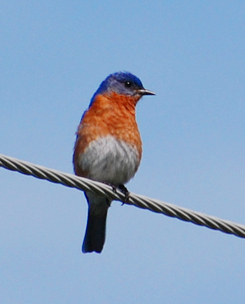
( More )
|
